Accounting and Finance: Breakeven Analysis and Investment Report
VerifiedAdded on 2023/01/05
|14
|3994
|67
Report
AI Summary
This report provides a comprehensive overview of key accounting and finance concepts. It begins with the formulation of an income statement and statement of financial position for Collins Colman Limited, demonstrating an understanding of financial statement analysis. The report then delves into breakeven analysis, calculating contribution, breakeven points, and margin of safety for a microwave product, along with an analysis of a potential business strategy. Furthermore, the report explores investment appraisal techniques, including payback period, accounting rate of return, and net present value, evaluating their merits and limitations. Finally, it discusses the benefits and limitations of using budgets for strategic planning, offering a well-rounded analysis of financial management principles. The report is a valuable resource for students seeking to understand and apply core financial concepts.
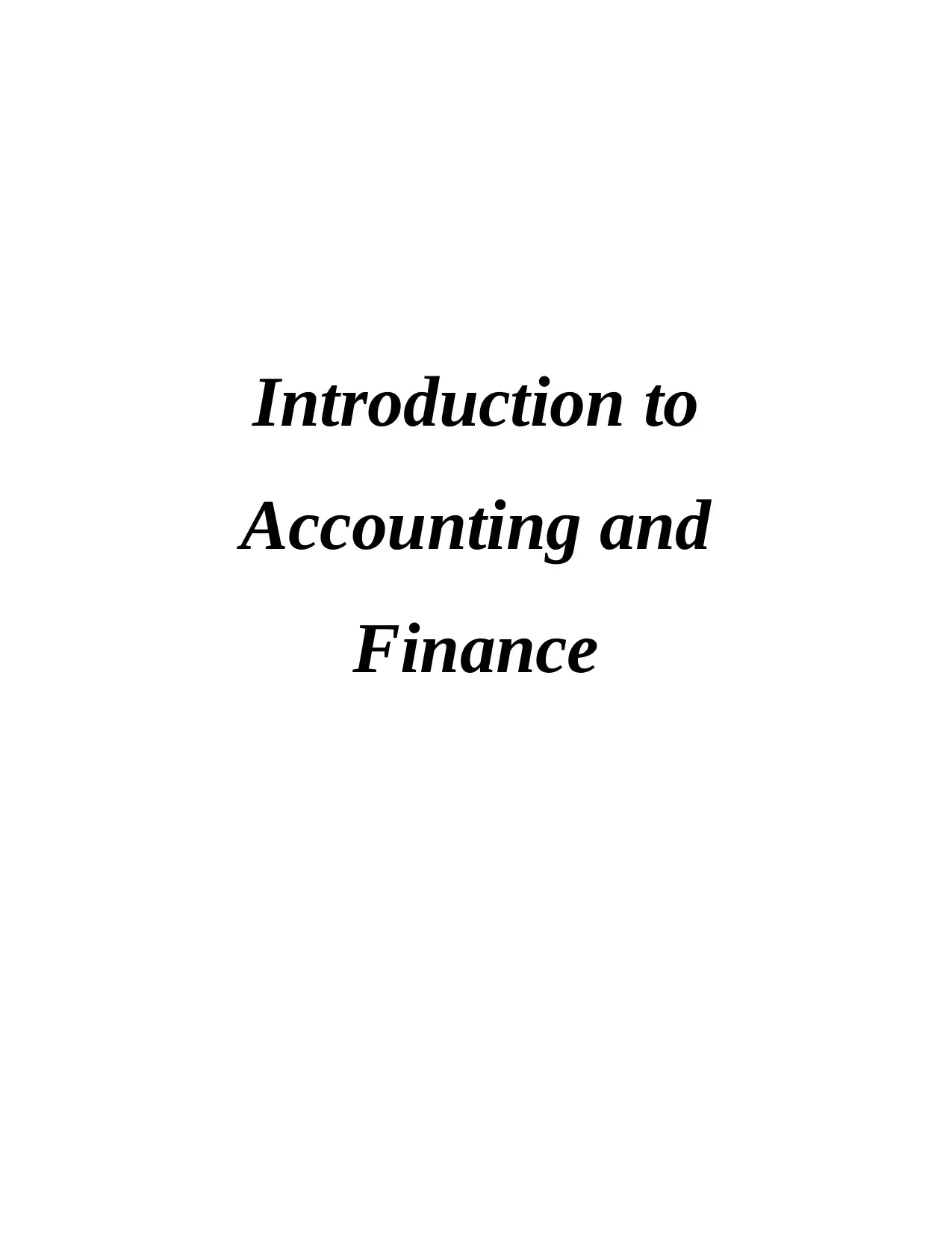
Introduction to
Accounting and
Finance
Accounting and
Finance
Paraphrase This Document
Need a fresh take? Get an instant paraphrase of this document with our AI Paraphraser
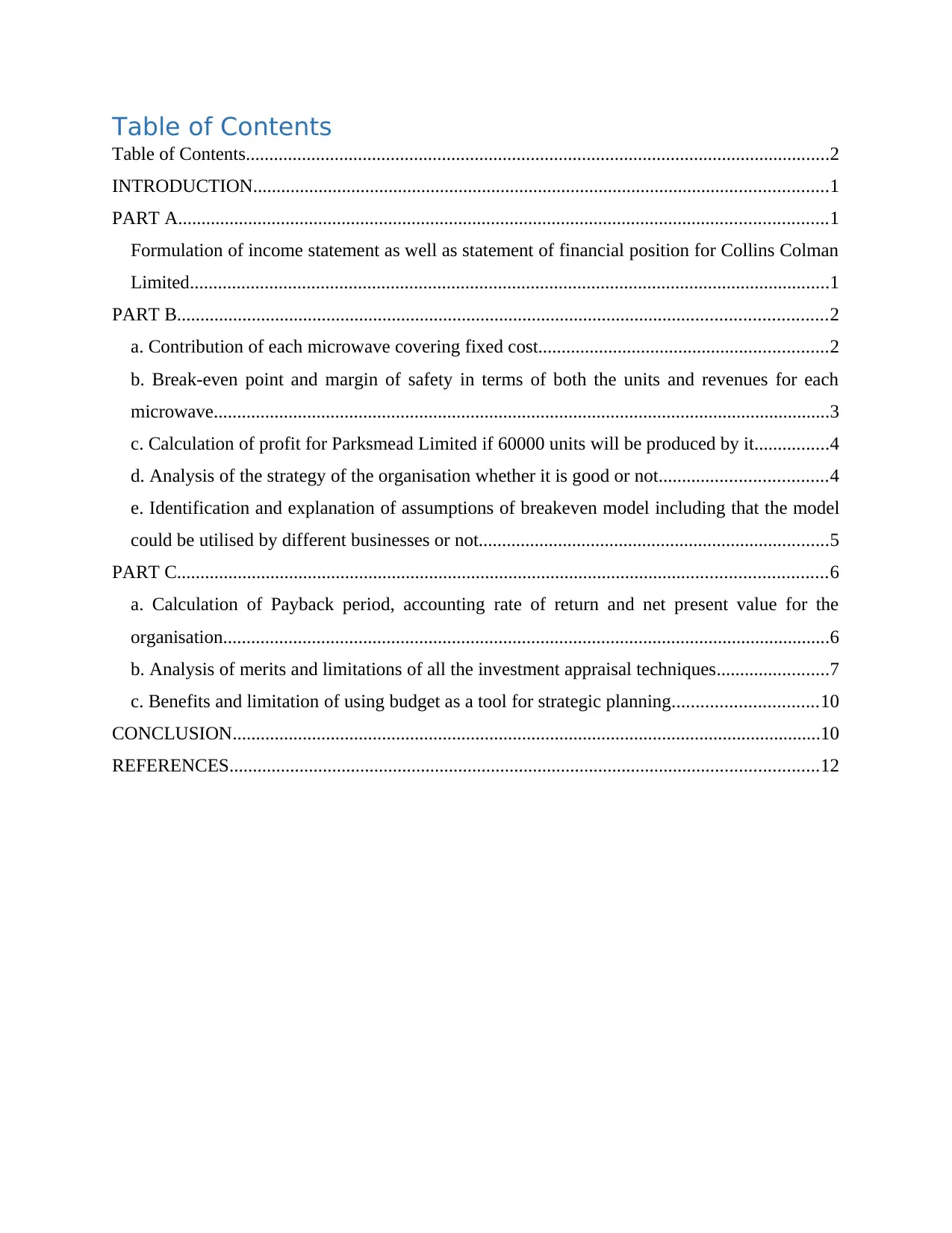
Table of Contents
Table of Contents.............................................................................................................................2
INTRODUCTION...........................................................................................................................1
PART A...........................................................................................................................................1
Formulation of income statement as well as statement of financial position for Collins Colman
Limited.........................................................................................................................................1
PART B...........................................................................................................................................2
a. Contribution of each microwave covering fixed cost..............................................................2
b. Break-even point and margin of safety in terms of both the units and revenues for each
microwave....................................................................................................................................3
c. Calculation of profit for Parksmead Limited if 60000 units will be produced by it................4
d. Analysis of the strategy of the organisation whether it is good or not....................................4
e. Identification and explanation of assumptions of breakeven model including that the model
could be utilised by different businesses or not...........................................................................5
PART C...........................................................................................................................................6
a. Calculation of Payback period, accounting rate of return and net present value for the
organisation..................................................................................................................................6
b. Analysis of merits and limitations of all the investment appraisal techniques........................7
c. Benefits and limitation of using budget as a tool for strategic planning...............................10
CONCLUSION..............................................................................................................................10
REFERENCES..............................................................................................................................12
Table of Contents.............................................................................................................................2
INTRODUCTION...........................................................................................................................1
PART A...........................................................................................................................................1
Formulation of income statement as well as statement of financial position for Collins Colman
Limited.........................................................................................................................................1
PART B...........................................................................................................................................2
a. Contribution of each microwave covering fixed cost..............................................................2
b. Break-even point and margin of safety in terms of both the units and revenues for each
microwave....................................................................................................................................3
c. Calculation of profit for Parksmead Limited if 60000 units will be produced by it................4
d. Analysis of the strategy of the organisation whether it is good or not....................................4
e. Identification and explanation of assumptions of breakeven model including that the model
could be utilised by different businesses or not...........................................................................5
PART C...........................................................................................................................................6
a. Calculation of Payback period, accounting rate of return and net present value for the
organisation..................................................................................................................................6
b. Analysis of merits and limitations of all the investment appraisal techniques........................7
c. Benefits and limitation of using budget as a tool for strategic planning...............................10
CONCLUSION..............................................................................................................................10
REFERENCES..............................................................................................................................12
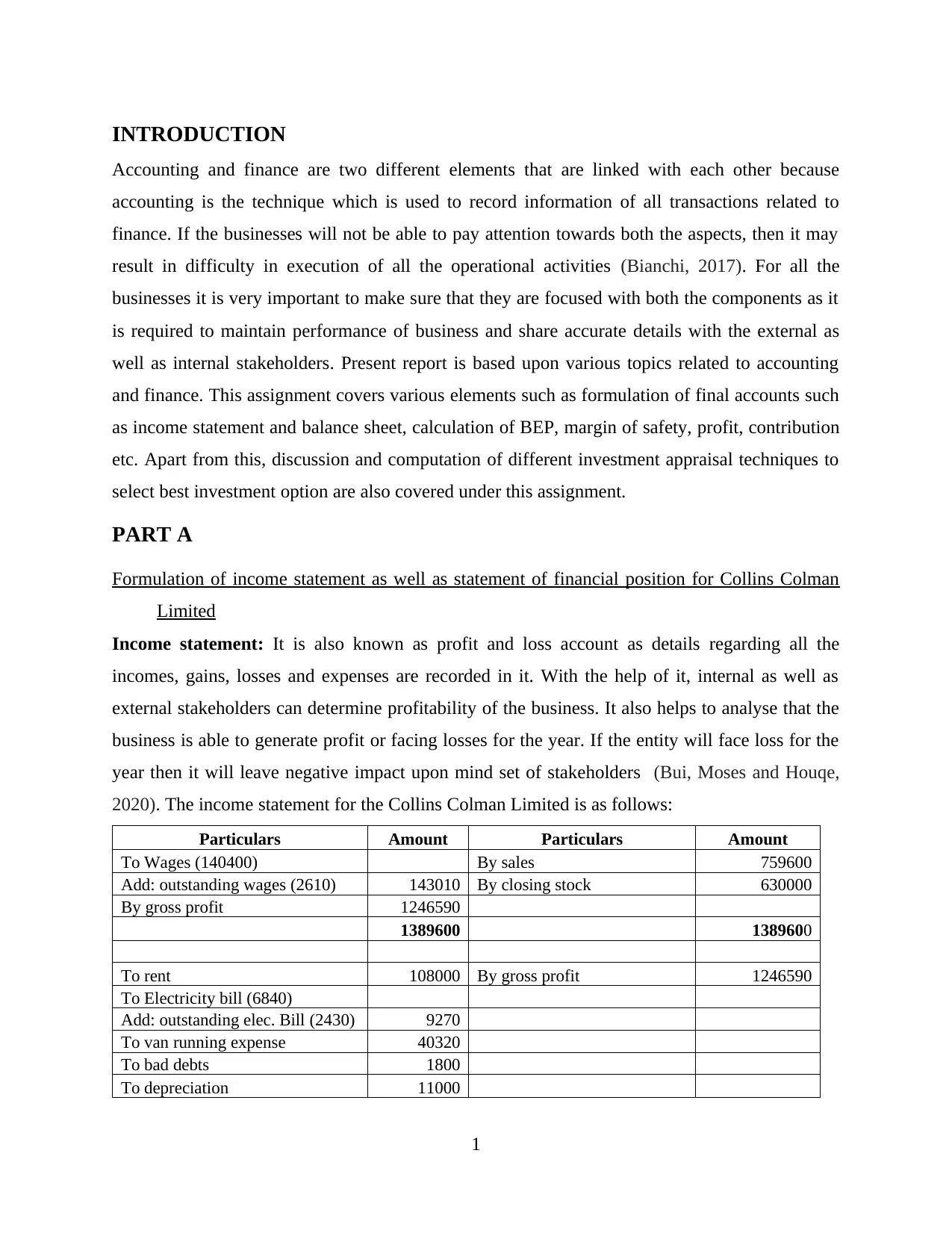
INTRODUCTION
Accounting and finance are two different elements that are linked with each other because
accounting is the technique which is used to record information of all transactions related to
finance. If the businesses will not be able to pay attention towards both the aspects, then it may
result in difficulty in execution of all the operational activities (Bianchi, 2017). For all the
businesses it is very important to make sure that they are focused with both the components as it
is required to maintain performance of business and share accurate details with the external as
well as internal stakeholders. Present report is based upon various topics related to accounting
and finance. This assignment covers various elements such as formulation of final accounts such
as income statement and balance sheet, calculation of BEP, margin of safety, profit, contribution
etc. Apart from this, discussion and computation of different investment appraisal techniques to
select best investment option are also covered under this assignment.
PART A
Formulation of income statement as well as statement of financial position for Collins Colman
Limited
Income statement: It is also known as profit and loss account as details regarding all the
incomes, gains, losses and expenses are recorded in it. With the help of it, internal as well as
external stakeholders can determine profitability of the business. It also helps to analyse that the
business is able to generate profit or facing losses for the year. If the entity will face loss for the
year then it will leave negative impact upon mind set of stakeholders (Bui, Moses and Houqe,
2020). The income statement for the Collins Colman Limited is as follows:
Particulars Amount Particulars Amount
To Wages (140400) By sales 759600
Add: outstanding wages (2610) 143010 By closing stock 630000
By gross profit 1246590
1389600 1389600
To rent 108000 By gross profit 1246590
To Electricity bill (6840)
Add: outstanding elec. Bill (2430) 9270
To van running expense 40320
To bad debts 1800
To depreciation 11000
1
Accounting and finance are two different elements that are linked with each other because
accounting is the technique which is used to record information of all transactions related to
finance. If the businesses will not be able to pay attention towards both the aspects, then it may
result in difficulty in execution of all the operational activities (Bianchi, 2017). For all the
businesses it is very important to make sure that they are focused with both the components as it
is required to maintain performance of business and share accurate details with the external as
well as internal stakeholders. Present report is based upon various topics related to accounting
and finance. This assignment covers various elements such as formulation of final accounts such
as income statement and balance sheet, calculation of BEP, margin of safety, profit, contribution
etc. Apart from this, discussion and computation of different investment appraisal techniques to
select best investment option are also covered under this assignment.
PART A
Formulation of income statement as well as statement of financial position for Collins Colman
Limited
Income statement: It is also known as profit and loss account as details regarding all the
incomes, gains, losses and expenses are recorded in it. With the help of it, internal as well as
external stakeholders can determine profitability of the business. It also helps to analyse that the
business is able to generate profit or facing losses for the year. If the entity will face loss for the
year then it will leave negative impact upon mind set of stakeholders (Bui, Moses and Houqe,
2020). The income statement for the Collins Colman Limited is as follows:
Particulars Amount Particulars Amount
To Wages (140400) By sales 759600
Add: outstanding wages (2610) 143010 By closing stock 630000
By gross profit 1246590
1389600 1389600
To rent 108000 By gross profit 1246590
To Electricity bill (6840)
Add: outstanding elec. Bill (2430) 9270
To van running expense 40320
To bad debts 1800
To depreciation 11000
1
⊘ This is a preview!⊘
Do you want full access?
Subscribe today to unlock all pages.

Trusted by 1+ million students worldwide
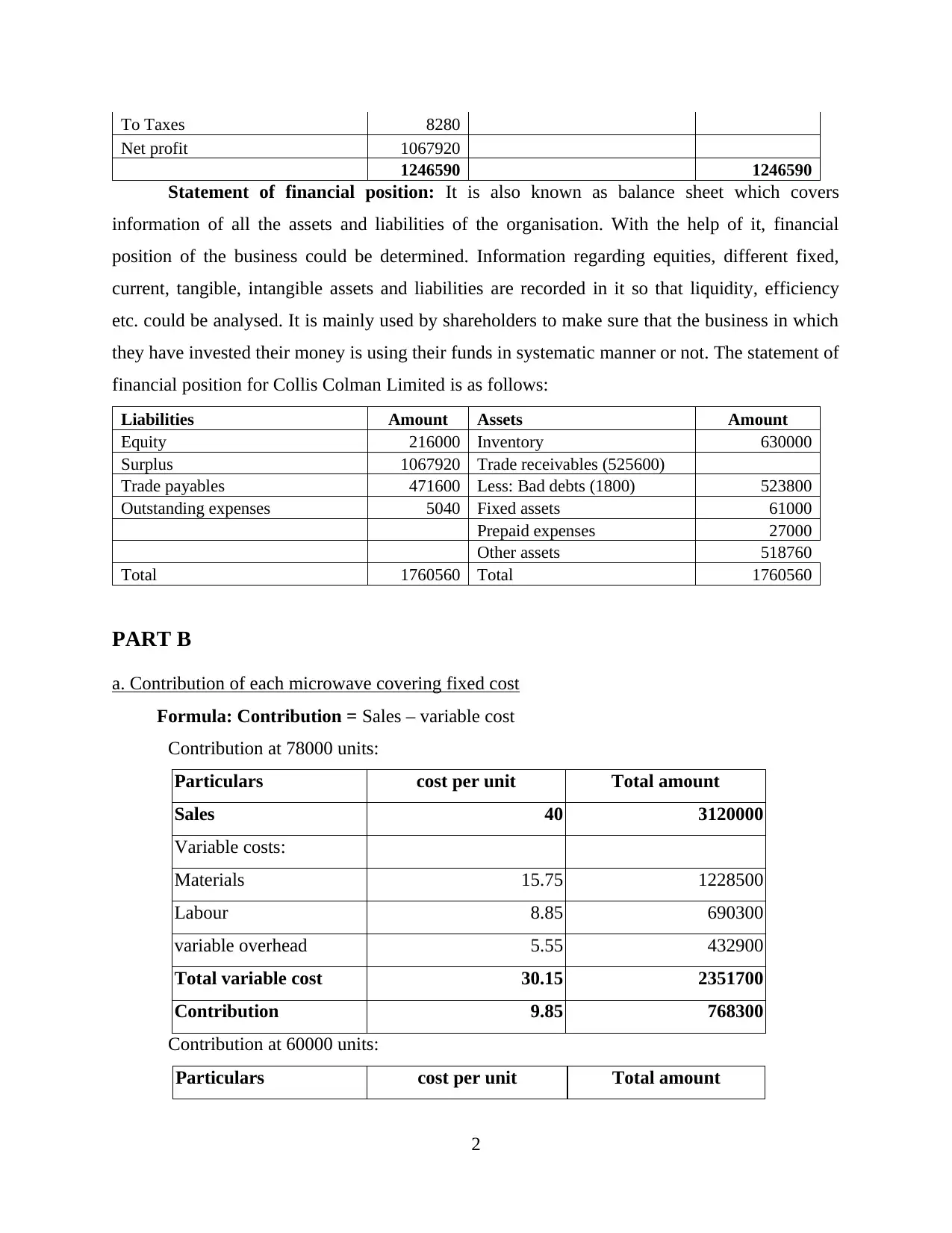
To Taxes 8280
Net profit 1067920
1246590 1246590
Statement of financial position: It is also known as balance sheet which covers
information of all the assets and liabilities of the organisation. With the help of it, financial
position of the business could be determined. Information regarding equities, different fixed,
current, tangible, intangible assets and liabilities are recorded in it so that liquidity, efficiency
etc. could be analysed. It is mainly used by shareholders to make sure that the business in which
they have invested their money is using their funds in systematic manner or not. The statement of
financial position for Collis Colman Limited is as follows:
Liabilities Amount Assets Amount
Equity 216000 Inventory 630000
Surplus 1067920 Trade receivables (525600)
Trade payables 471600 Less: Bad debts (1800) 523800
Outstanding expenses 5040 Fixed assets 61000
Prepaid expenses 27000
Other assets 518760
Total 1760560 Total 1760560
PART B
a. Contribution of each microwave covering fixed cost
Formula: Contribution = Sales – variable cost
Contribution at 78000 units:
Particulars cost per unit Total amount
Sales 40 3120000
Variable costs:
Materials 15.75 1228500
Labour 8.85 690300
variable overhead 5.55 432900
Total variable cost 30.15 2351700
Contribution 9.85 768300
Contribution at 60000 units:
Particulars cost per unit Total amount
2
Net profit 1067920
1246590 1246590
Statement of financial position: It is also known as balance sheet which covers
information of all the assets and liabilities of the organisation. With the help of it, financial
position of the business could be determined. Information regarding equities, different fixed,
current, tangible, intangible assets and liabilities are recorded in it so that liquidity, efficiency
etc. could be analysed. It is mainly used by shareholders to make sure that the business in which
they have invested their money is using their funds in systematic manner or not. The statement of
financial position for Collis Colman Limited is as follows:
Liabilities Amount Assets Amount
Equity 216000 Inventory 630000
Surplus 1067920 Trade receivables (525600)
Trade payables 471600 Less: Bad debts (1800) 523800
Outstanding expenses 5040 Fixed assets 61000
Prepaid expenses 27000
Other assets 518760
Total 1760560 Total 1760560
PART B
a. Contribution of each microwave covering fixed cost
Formula: Contribution = Sales – variable cost
Contribution at 78000 units:
Particulars cost per unit Total amount
Sales 40 3120000
Variable costs:
Materials 15.75 1228500
Labour 8.85 690300
variable overhead 5.55 432900
Total variable cost 30.15 2351700
Contribution 9.85 768300
Contribution at 60000 units:
Particulars cost per unit Total amount
2
Paraphrase This Document
Need a fresh take? Get an instant paraphrase of this document with our AI Paraphraser
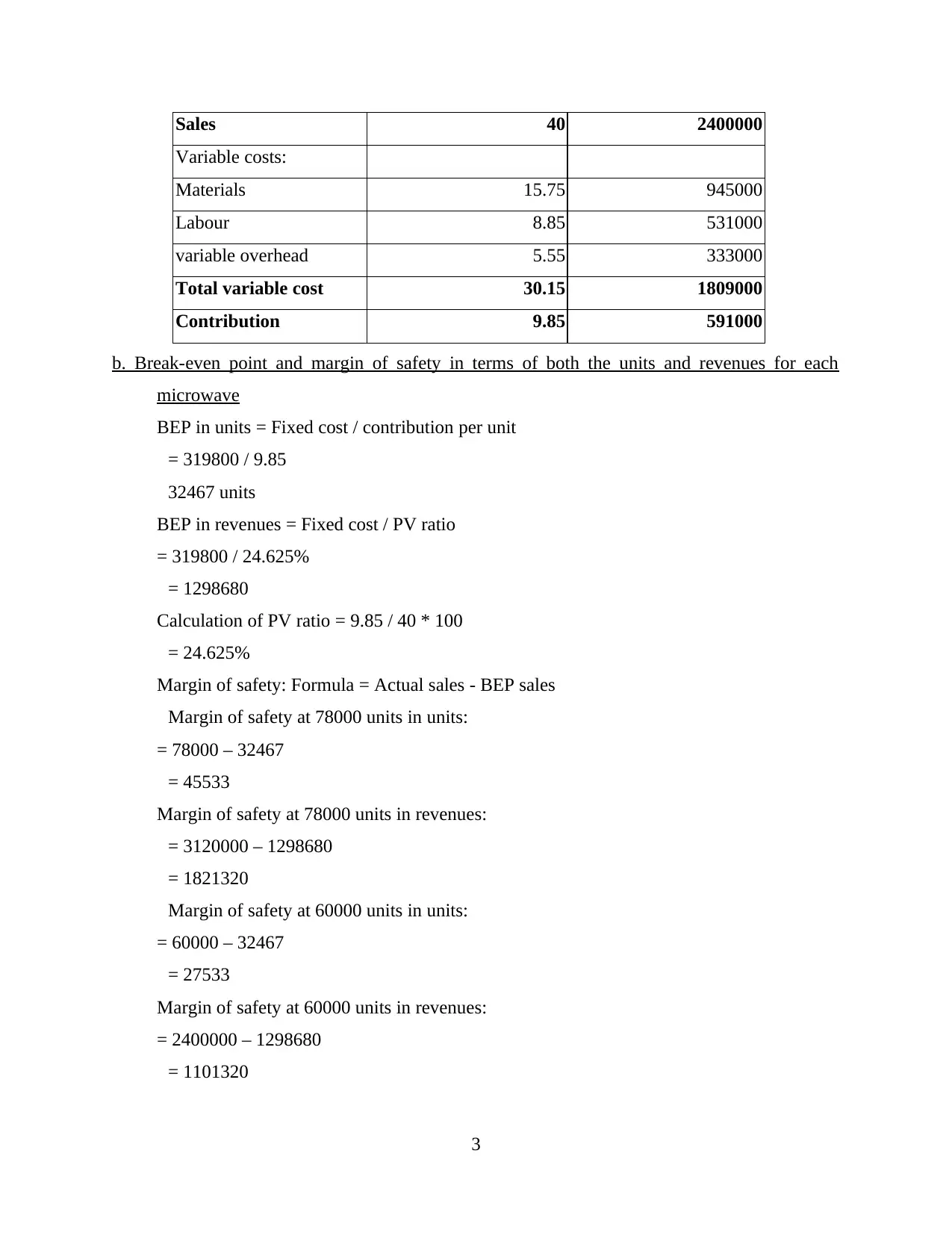
Sales 40 2400000
Variable costs:
Materials 15.75 945000
Labour 8.85 531000
variable overhead 5.55 333000
Total variable cost 30.15 1809000
Contribution 9.85 591000
b. Break-even point and margin of safety in terms of both the units and revenues for each
microwave
BEP in units = Fixed cost / contribution per unit
= 319800 / 9.85
32467 units
BEP in revenues = Fixed cost / PV ratio
= 319800 / 24.625%
= 1298680
Calculation of PV ratio = 9.85 / 40 * 100
= 24.625%
Margin of safety: Formula = Actual sales - BEP sales
Margin of safety at 78000 units in units:
= 78000 – 32467
= 45533
Margin of safety at 78000 units in revenues:
= 3120000 – 1298680
= 1821320
Margin of safety at 60000 units in units:
= 60000 – 32467
= 27533
Margin of safety at 60000 units in revenues:
= 2400000 – 1298680
= 1101320
3
Variable costs:
Materials 15.75 945000
Labour 8.85 531000
variable overhead 5.55 333000
Total variable cost 30.15 1809000
Contribution 9.85 591000
b. Break-even point and margin of safety in terms of both the units and revenues for each
microwave
BEP in units = Fixed cost / contribution per unit
= 319800 / 9.85
32467 units
BEP in revenues = Fixed cost / PV ratio
= 319800 / 24.625%
= 1298680
Calculation of PV ratio = 9.85 / 40 * 100
= 24.625%
Margin of safety: Formula = Actual sales - BEP sales
Margin of safety at 78000 units in units:
= 78000 – 32467
= 45533
Margin of safety at 78000 units in revenues:
= 3120000 – 1298680
= 1821320
Margin of safety at 60000 units in units:
= 60000 – 32467
= 27533
Margin of safety at 60000 units in revenues:
= 2400000 – 1298680
= 1101320
3
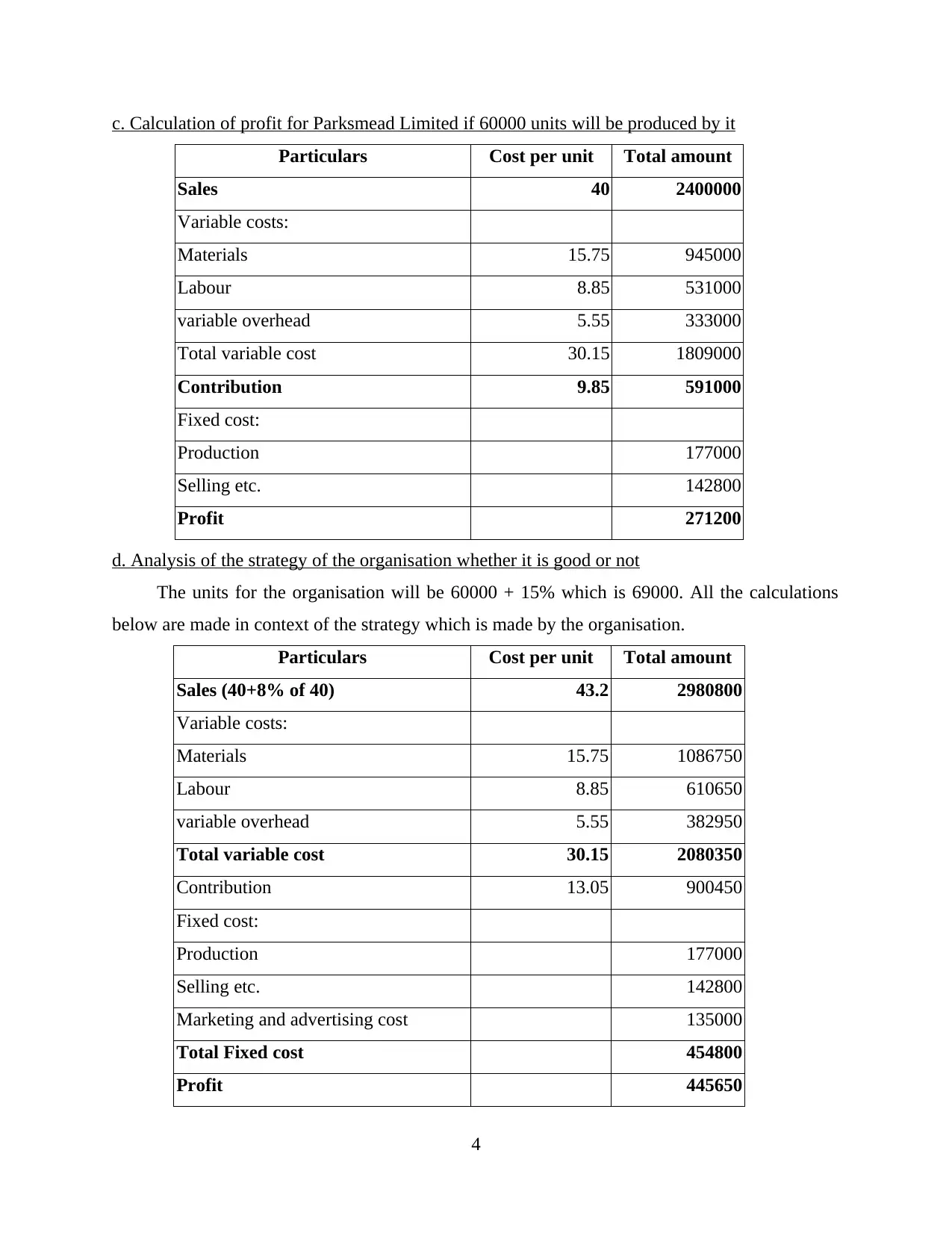
c. Calculation of profit for Parksmead Limited if 60000 units will be produced by it
Particulars Cost per unit Total amount
Sales 40 2400000
Variable costs:
Materials 15.75 945000
Labour 8.85 531000
variable overhead 5.55 333000
Total variable cost 30.15 1809000
Contribution 9.85 591000
Fixed cost:
Production 177000
Selling etc. 142800
Profit 271200
d. Analysis of the strategy of the organisation whether it is good or not
The units for the organisation will be 60000 + 15% which is 69000. All the calculations
below are made in context of the strategy which is made by the organisation.
Particulars Cost per unit Total amount
Sales (40+8% of 40) 43.2 2980800
Variable costs:
Materials 15.75 1086750
Labour 8.85 610650
variable overhead 5.55 382950
Total variable cost 30.15 2080350
Contribution 13.05 900450
Fixed cost:
Production 177000
Selling etc. 142800
Marketing and advertising cost 135000
Total Fixed cost 454800
Profit 445650
4
Particulars Cost per unit Total amount
Sales 40 2400000
Variable costs:
Materials 15.75 945000
Labour 8.85 531000
variable overhead 5.55 333000
Total variable cost 30.15 1809000
Contribution 9.85 591000
Fixed cost:
Production 177000
Selling etc. 142800
Profit 271200
d. Analysis of the strategy of the organisation whether it is good or not
The units for the organisation will be 60000 + 15% which is 69000. All the calculations
below are made in context of the strategy which is made by the organisation.
Particulars Cost per unit Total amount
Sales (40+8% of 40) 43.2 2980800
Variable costs:
Materials 15.75 1086750
Labour 8.85 610650
variable overhead 5.55 382950
Total variable cost 30.15 2080350
Contribution 13.05 900450
Fixed cost:
Production 177000
Selling etc. 142800
Marketing and advertising cost 135000
Total Fixed cost 454800
Profit 445650
4
⊘ This is a preview!⊘
Do you want full access?
Subscribe today to unlock all pages.

Trusted by 1+ million students worldwide
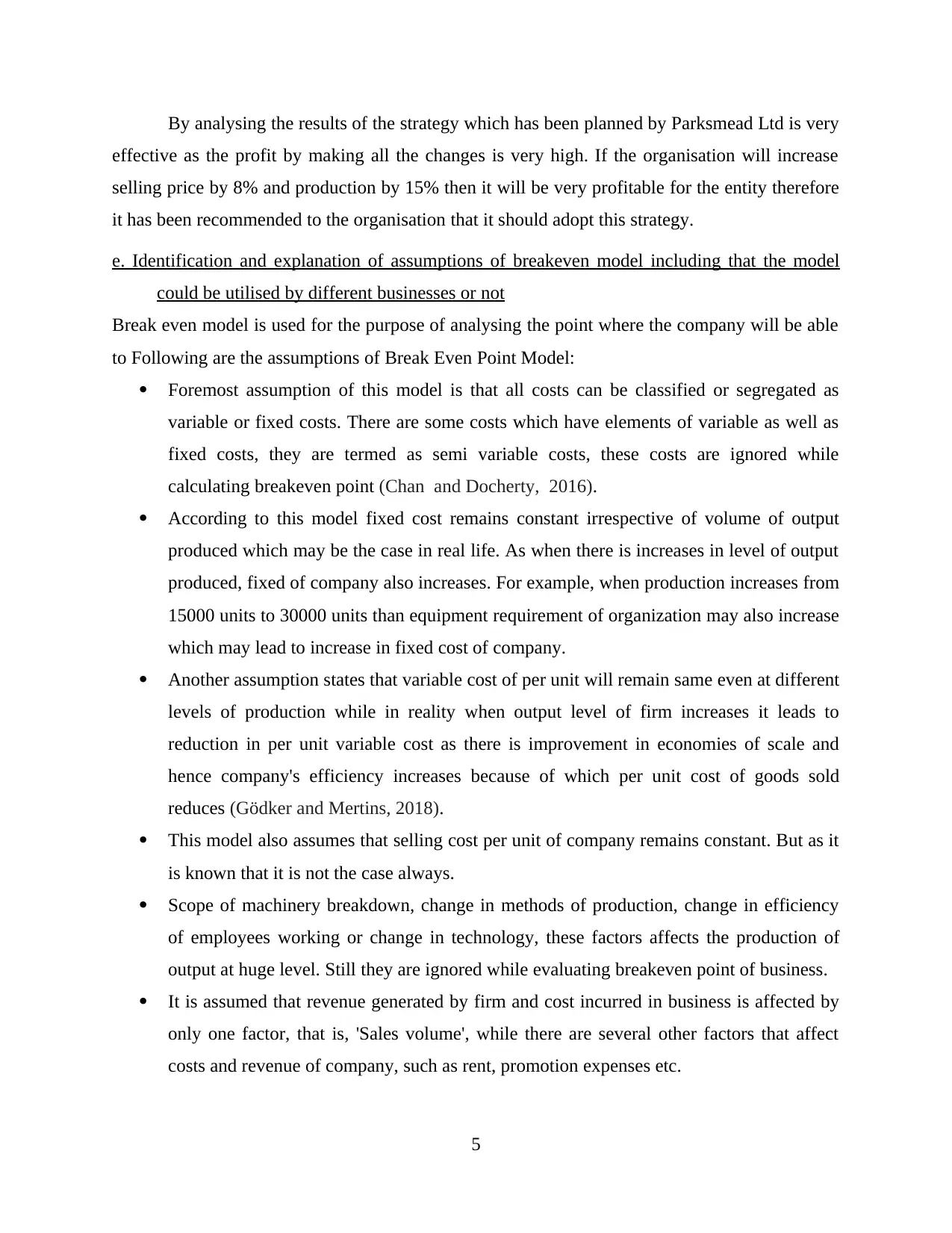
By analysing the results of the strategy which has been planned by Parksmead Ltd is very
effective as the profit by making all the changes is very high. If the organisation will increase
selling price by 8% and production by 15% then it will be very profitable for the entity therefore
it has been recommended to the organisation that it should adopt this strategy.
e. Identification and explanation of assumptions of breakeven model including that the model
could be utilised by different businesses or not
Break even model is used for the purpose of analysing the point where the company will be able
to Following are the assumptions of Break Even Point Model:
Foremost assumption of this model is that all costs can be classified or segregated as
variable or fixed costs. There are some costs which have elements of variable as well as
fixed costs, they are termed as semi variable costs, these costs are ignored while
calculating breakeven point (Chan and Docherty, 2016).
According to this model fixed cost remains constant irrespective of volume of output
produced which may be the case in real life. As when there is increases in level of output
produced, fixed of company also increases. For example, when production increases from
15000 units to 30000 units than equipment requirement of organization may also increase
which may lead to increase in fixed cost of company.
Another assumption states that variable cost of per unit will remain same even at different
levels of production while in reality when output level of firm increases it leads to
reduction in per unit variable cost as there is improvement in economies of scale and
hence company's efficiency increases because of which per unit cost of goods sold
reduces (Gödker and Mertins, 2018).
This model also assumes that selling cost per unit of company remains constant. But as it
is known that it is not the case always.
Scope of machinery breakdown, change in methods of production, change in efficiency
of employees working or change in technology, these factors affects the production of
output at huge level. Still they are ignored while evaluating breakeven point of business.
It is assumed that revenue generated by firm and cost incurred in business is affected by
only one factor, that is, 'Sales volume', while there are several other factors that affect
costs and revenue of company, such as rent, promotion expenses etc.
5
effective as the profit by making all the changes is very high. If the organisation will increase
selling price by 8% and production by 15% then it will be very profitable for the entity therefore
it has been recommended to the organisation that it should adopt this strategy.
e. Identification and explanation of assumptions of breakeven model including that the model
could be utilised by different businesses or not
Break even model is used for the purpose of analysing the point where the company will be able
to Following are the assumptions of Break Even Point Model:
Foremost assumption of this model is that all costs can be classified or segregated as
variable or fixed costs. There are some costs which have elements of variable as well as
fixed costs, they are termed as semi variable costs, these costs are ignored while
calculating breakeven point (Chan and Docherty, 2016).
According to this model fixed cost remains constant irrespective of volume of output
produced which may be the case in real life. As when there is increases in level of output
produced, fixed of company also increases. For example, when production increases from
15000 units to 30000 units than equipment requirement of organization may also increase
which may lead to increase in fixed cost of company.
Another assumption states that variable cost of per unit will remain same even at different
levels of production while in reality when output level of firm increases it leads to
reduction in per unit variable cost as there is improvement in economies of scale and
hence company's efficiency increases because of which per unit cost of goods sold
reduces (Gödker and Mertins, 2018).
This model also assumes that selling cost per unit of company remains constant. But as it
is known that it is not the case always.
Scope of machinery breakdown, change in methods of production, change in efficiency
of employees working or change in technology, these factors affects the production of
output at huge level. Still they are ignored while evaluating breakeven point of business.
It is assumed that revenue generated by firm and cost incurred in business is affected by
only one factor, that is, 'Sales volume', while there are several other factors that affect
costs and revenue of company, such as rent, promotion expenses etc.
5
Paraphrase This Document
Need a fresh take? Get an instant paraphrase of this document with our AI Paraphraser
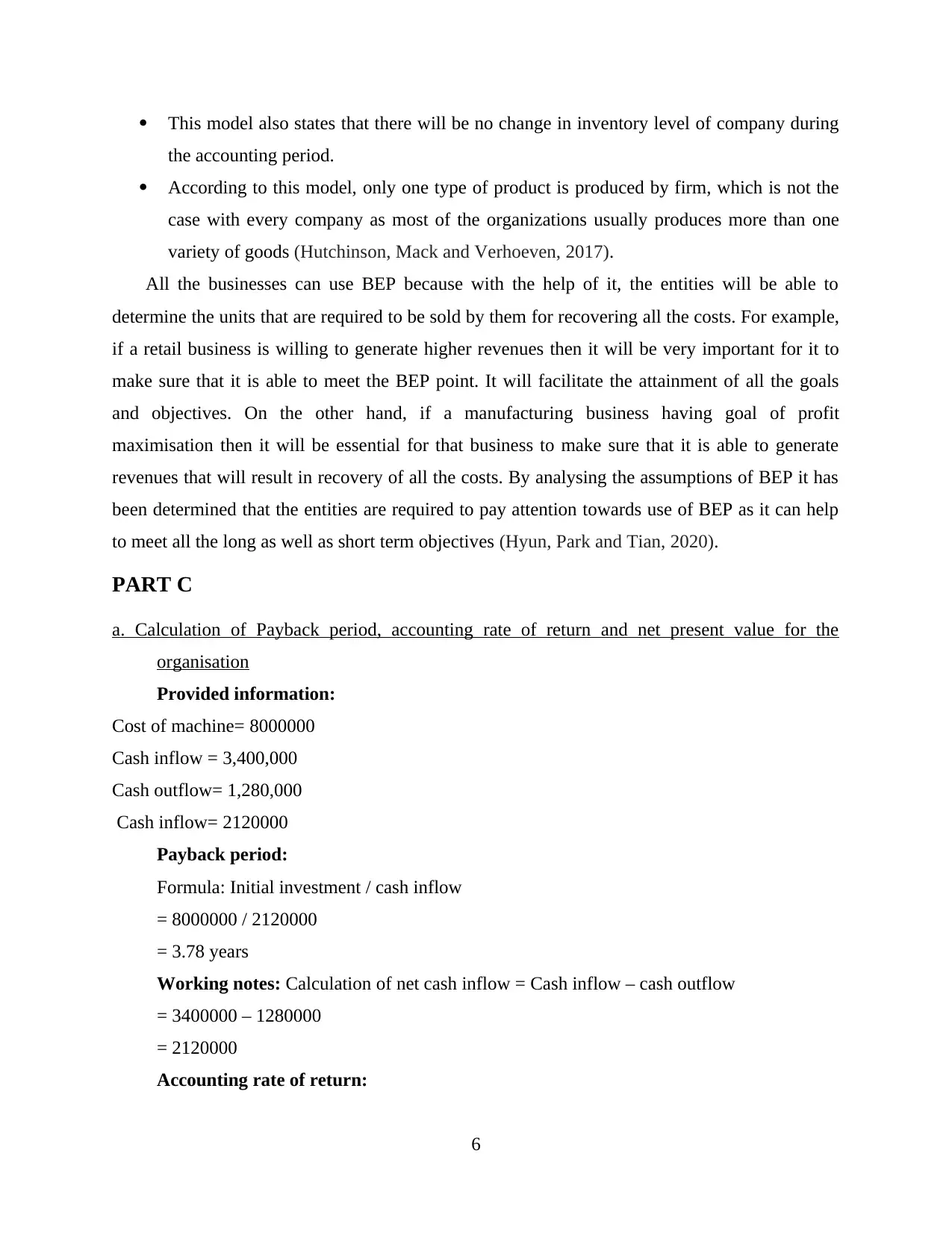
This model also states that there will be no change in inventory level of company during
the accounting period.
According to this model, only one type of product is produced by firm, which is not the
case with every company as most of the organizations usually produces more than one
variety of goods (Hutchinson, Mack and Verhoeven, 2017).
All the businesses can use BEP because with the help of it, the entities will be able to
determine the units that are required to be sold by them for recovering all the costs. For example,
if a retail business is willing to generate higher revenues then it will be very important for it to
make sure that it is able to meet the BEP point. It will facilitate the attainment of all the goals
and objectives. On the other hand, if a manufacturing business having goal of profit
maximisation then it will be essential for that business to make sure that it is able to generate
revenues that will result in recovery of all the costs. By analysing the assumptions of BEP it has
been determined that the entities are required to pay attention towards use of BEP as it can help
to meet all the long as well as short term objectives (Hyun, Park and Tian, 2020).
PART C
a. Calculation of Payback period, accounting rate of return and net present value for the
organisation
Provided information:
Cost of machine= 8000000
Cash inflow = 3,400,000
Cash outflow= 1,280,000
Cash inflow= 2120000
Payback period:
Formula: Initial investment / cash inflow
= 8000000 / 2120000
= 3.78 years
Working notes: Calculation of net cash inflow = Cash inflow – cash outflow
= 3400000 – 1280000
= 2120000
Accounting rate of return:
6
the accounting period.
According to this model, only one type of product is produced by firm, which is not the
case with every company as most of the organizations usually produces more than one
variety of goods (Hutchinson, Mack and Verhoeven, 2017).
All the businesses can use BEP because with the help of it, the entities will be able to
determine the units that are required to be sold by them for recovering all the costs. For example,
if a retail business is willing to generate higher revenues then it will be very important for it to
make sure that it is able to meet the BEP point. It will facilitate the attainment of all the goals
and objectives. On the other hand, if a manufacturing business having goal of profit
maximisation then it will be essential for that business to make sure that it is able to generate
revenues that will result in recovery of all the costs. By analysing the assumptions of BEP it has
been determined that the entities are required to pay attention towards use of BEP as it can help
to meet all the long as well as short term objectives (Hyun, Park and Tian, 2020).
PART C
a. Calculation of Payback period, accounting rate of return and net present value for the
organisation
Provided information:
Cost of machine= 8000000
Cash inflow = 3,400,000
Cash outflow= 1,280,000
Cash inflow= 2120000
Payback period:
Formula: Initial investment / cash inflow
= 8000000 / 2120000
= 3.78 years
Working notes: Calculation of net cash inflow = Cash inflow – cash outflow
= 3400000 – 1280000
= 2120000
Accounting rate of return:
6
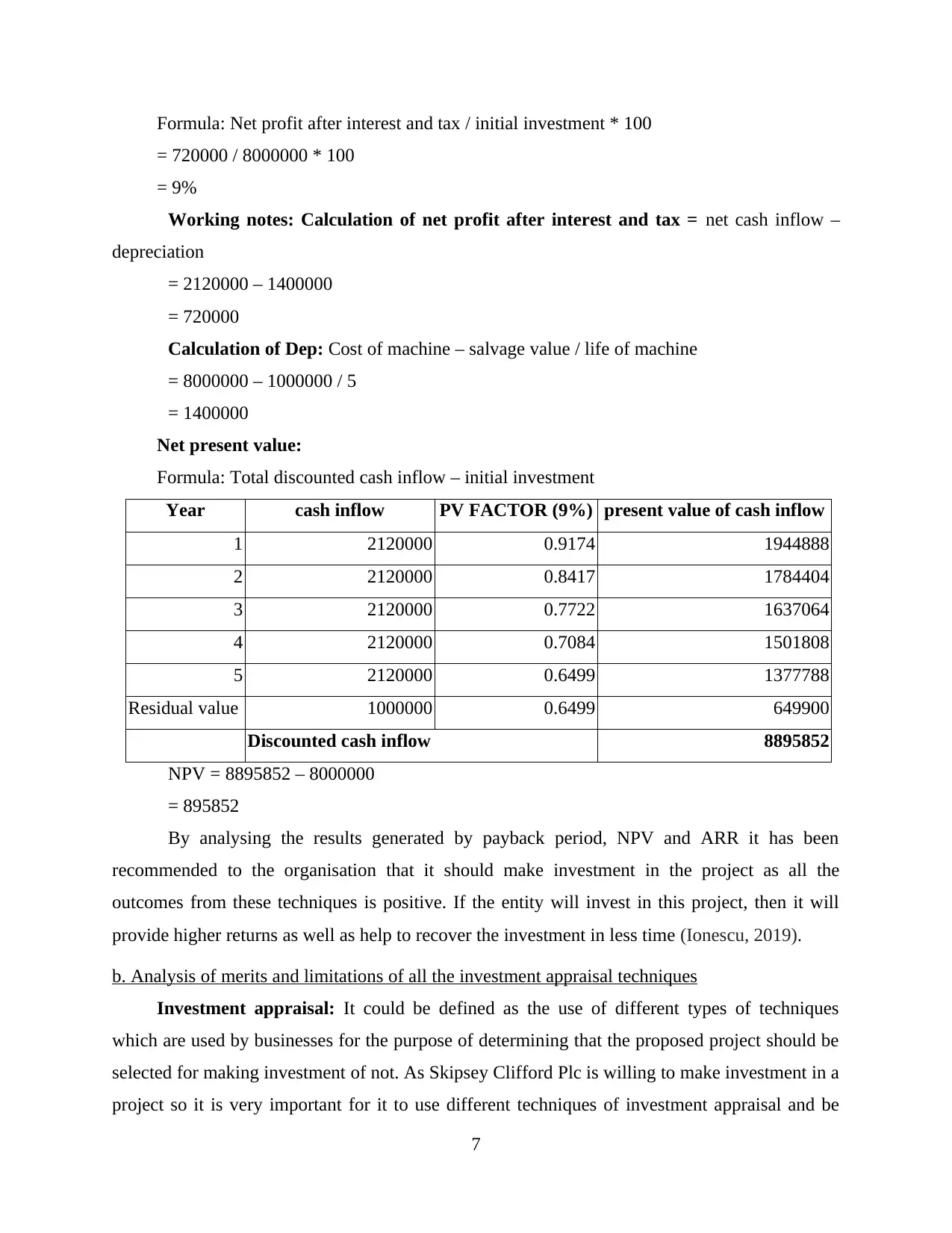
Formula: Net profit after interest and tax / initial investment * 100
= 720000 / 8000000 * 100
= 9%
Working notes: Calculation of net profit after interest and tax = net cash inflow –
depreciation
= 2120000 – 1400000
= 720000
Calculation of Dep: Cost of machine – salvage value / life of machine
= 8000000 – 1000000 / 5
= 1400000
Net present value:
Formula: Total discounted cash inflow – initial investment
Year cash inflow PV FACTOR (9%) present value of cash inflow
1 2120000 0.9174 1944888
2 2120000 0.8417 1784404
3 2120000 0.7722 1637064
4 2120000 0.7084 1501808
5 2120000 0.6499 1377788
Residual value 1000000 0.6499 649900
Discounted cash inflow 8895852
NPV = 8895852 – 8000000
= 895852
By analysing the results generated by payback period, NPV and ARR it has been
recommended to the organisation that it should make investment in the project as all the
outcomes from these techniques is positive. If the entity will invest in this project, then it will
provide higher returns as well as help to recover the investment in less time (Ionescu, 2019).
b. Analysis of merits and limitations of all the investment appraisal techniques
Investment appraisal: It could be defined as the use of different types of techniques
which are used by businesses for the purpose of determining that the proposed project should be
selected for making investment of not. As Skipsey Clifford Plc is willing to make investment in a
project so it is very important for it to use different techniques of investment appraisal and be
7
= 720000 / 8000000 * 100
= 9%
Working notes: Calculation of net profit after interest and tax = net cash inflow –
depreciation
= 2120000 – 1400000
= 720000
Calculation of Dep: Cost of machine – salvage value / life of machine
= 8000000 – 1000000 / 5
= 1400000
Net present value:
Formula: Total discounted cash inflow – initial investment
Year cash inflow PV FACTOR (9%) present value of cash inflow
1 2120000 0.9174 1944888
2 2120000 0.8417 1784404
3 2120000 0.7722 1637064
4 2120000 0.7084 1501808
5 2120000 0.6499 1377788
Residual value 1000000 0.6499 649900
Discounted cash inflow 8895852
NPV = 8895852 – 8000000
= 895852
By analysing the results generated by payback period, NPV and ARR it has been
recommended to the organisation that it should make investment in the project as all the
outcomes from these techniques is positive. If the entity will invest in this project, then it will
provide higher returns as well as help to recover the investment in less time (Ionescu, 2019).
b. Analysis of merits and limitations of all the investment appraisal techniques
Investment appraisal: It could be defined as the use of different types of techniques
which are used by businesses for the purpose of determining that the proposed project should be
selected for making investment of not. As Skipsey Clifford Plc is willing to make investment in a
project so it is very important for it to use different techniques of investment appraisal and be
7
⊘ This is a preview!⊘
Do you want full access?
Subscribe today to unlock all pages.

Trusted by 1+ million students worldwide
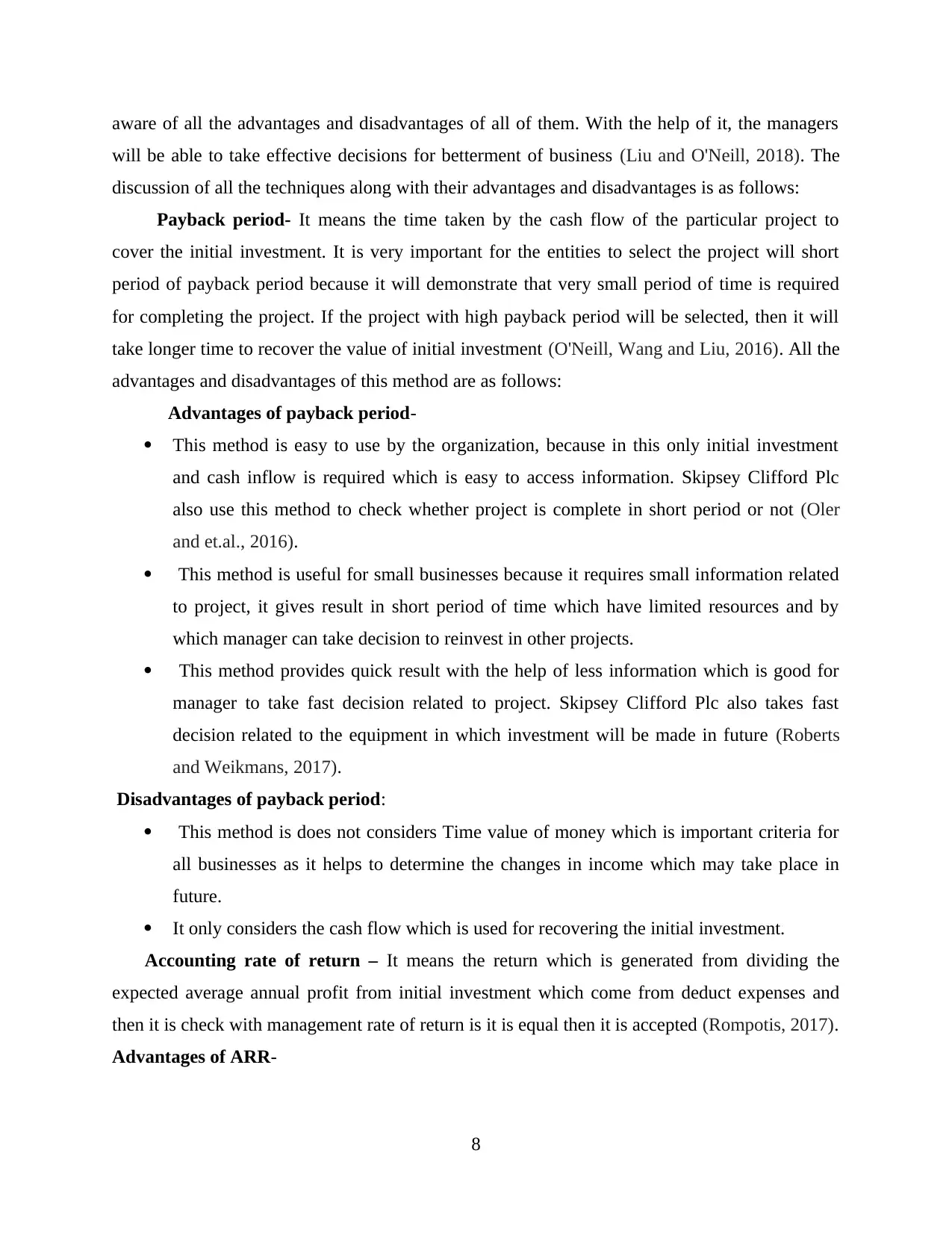
aware of all the advantages and disadvantages of all of them. With the help of it, the managers
will be able to take effective decisions for betterment of business (Liu and O'Neill, 2018). The
discussion of all the techniques along with their advantages and disadvantages is as follows:
Payback period- It means the time taken by the cash flow of the particular project to
cover the initial investment. It is very important for the entities to select the project will short
period of payback period because it will demonstrate that very small period of time is required
for completing the project. If the project with high payback period will be selected, then it will
take longer time to recover the value of initial investment (O'Neill, Wang and Liu, 2016). All the
advantages and disadvantages of this method are as follows:
Advantages of payback period-
This method is easy to use by the organization, because in this only initial investment
and cash inflow is required which is easy to access information. Skipsey Clifford Plc
also use this method to check whether project is complete in short period or not (Oler
and et.al., 2016).
This method is useful for small businesses because it requires small information related
to project, it gives result in short period of time which have limited resources and by
which manager can take decision to reinvest in other projects.
This method provides quick result with the help of less information which is good for
manager to take fast decision related to project. Skipsey Clifford Plc also takes fast
decision related to the equipment in which investment will be made in future (Roberts
and Weikmans, 2017).
Disadvantages of payback period:
This method is does not considers Time value of money which is important criteria for
all businesses as it helps to determine the changes in income which may take place in
future.
It only considers the cash flow which is used for recovering the initial investment.
Accounting rate of return – It means the return which is generated from dividing the
expected average annual profit from initial investment which come from deduct expenses and
then it is check with management rate of return is it is equal then it is accepted (Rompotis, 2017).
Advantages of ARR-
8
will be able to take effective decisions for betterment of business (Liu and O'Neill, 2018). The
discussion of all the techniques along with their advantages and disadvantages is as follows:
Payback period- It means the time taken by the cash flow of the particular project to
cover the initial investment. It is very important for the entities to select the project will short
period of payback period because it will demonstrate that very small period of time is required
for completing the project. If the project with high payback period will be selected, then it will
take longer time to recover the value of initial investment (O'Neill, Wang and Liu, 2016). All the
advantages and disadvantages of this method are as follows:
Advantages of payback period-
This method is easy to use by the organization, because in this only initial investment
and cash inflow is required which is easy to access information. Skipsey Clifford Plc
also use this method to check whether project is complete in short period or not (Oler
and et.al., 2016).
This method is useful for small businesses because it requires small information related
to project, it gives result in short period of time which have limited resources and by
which manager can take decision to reinvest in other projects.
This method provides quick result with the help of less information which is good for
manager to take fast decision related to project. Skipsey Clifford Plc also takes fast
decision related to the equipment in which investment will be made in future (Roberts
and Weikmans, 2017).
Disadvantages of payback period:
This method is does not considers Time value of money which is important criteria for
all businesses as it helps to determine the changes in income which may take place in
future.
It only considers the cash flow which is used for recovering the initial investment.
Accounting rate of return – It means the return which is generated from dividing the
expected average annual profit from initial investment which come from deduct expenses and
then it is check with management rate of return is it is equal then it is accepted (Rompotis, 2017).
Advantages of ARR-
8
Paraphrase This Document
Need a fresh take? Get an instant paraphrase of this document with our AI Paraphraser
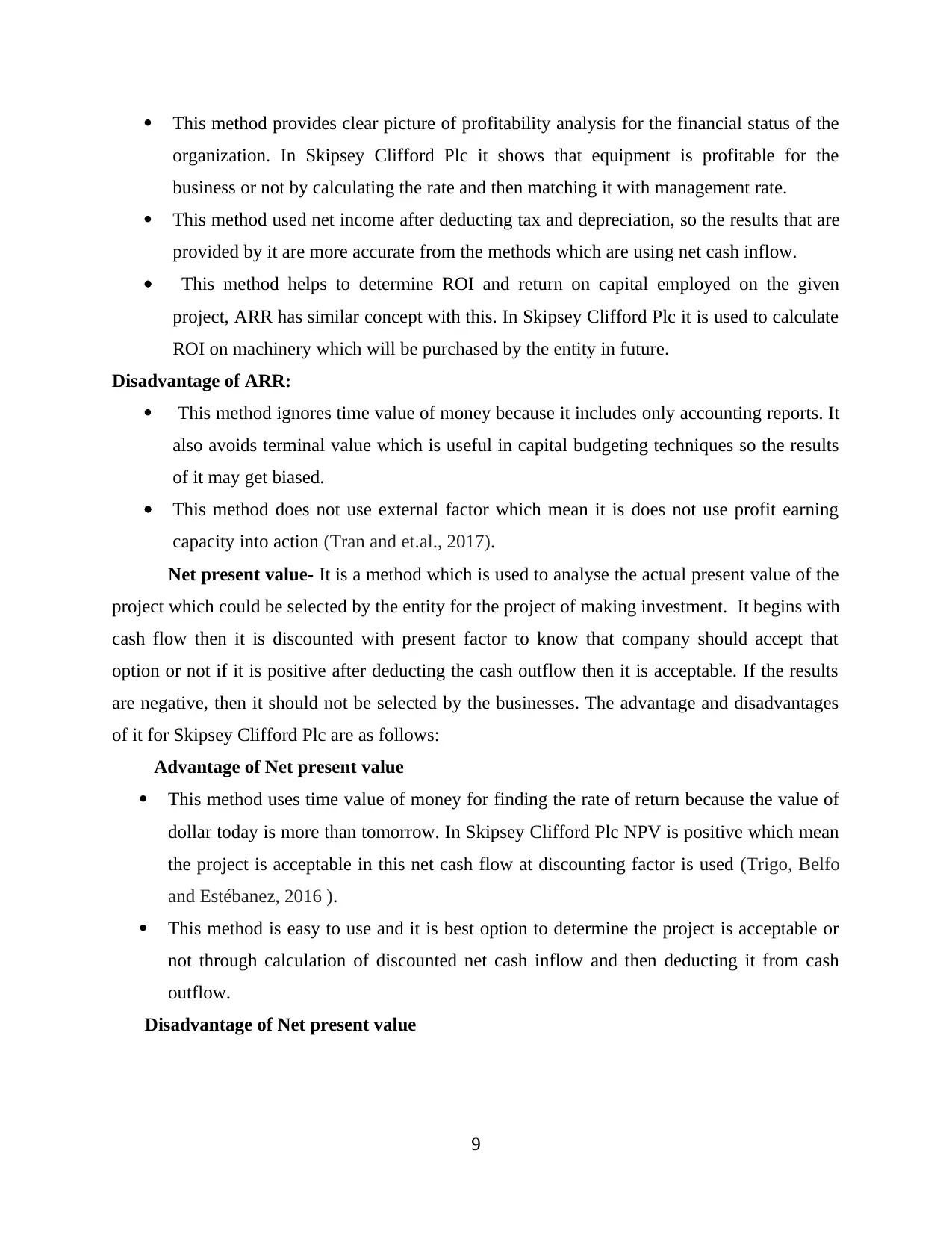
This method provides clear picture of profitability analysis for the financial status of the
organization. In Skipsey Clifford Plc it shows that equipment is profitable for the
business or not by calculating the rate and then matching it with management rate.
This method used net income after deducting tax and depreciation, so the results that are
provided by it are more accurate from the methods which are using net cash inflow.
This method helps to determine ROI and return on capital employed on the given
project, ARR has similar concept with this. In Skipsey Clifford Plc it is used to calculate
ROI on machinery which will be purchased by the entity in future.
Disadvantage of ARR:
This method ignores time value of money because it includes only accounting reports. It
also avoids terminal value which is useful in capital budgeting techniques so the results
of it may get biased.
This method does not use external factor which mean it is does not use profit earning
capacity into action (Tran and et.al., 2017).
Net present value- It is a method which is used to analyse the actual present value of the
project which could be selected by the entity for the project of making investment. It begins with
cash flow then it is discounted with present factor to know that company should accept that
option or not if it is positive after deducting the cash outflow then it is acceptable. If the results
are negative, then it should not be selected by the businesses. The advantage and disadvantages
of it for Skipsey Clifford Plc are as follows:
Advantage of Net present value
This method uses time value of money for finding the rate of return because the value of
dollar today is more than tomorrow. In Skipsey Clifford Plc NPV is positive which mean
the project is acceptable in this net cash flow at discounting factor is used (Trigo, Belfo
and Estébanez, 2016 ).
This method is easy to use and it is best option to determine the project is acceptable or
not through calculation of discounted net cash inflow and then deducting it from cash
outflow.
Disadvantage of Net present value
9
organization. In Skipsey Clifford Plc it shows that equipment is profitable for the
business or not by calculating the rate and then matching it with management rate.
This method used net income after deducting tax and depreciation, so the results that are
provided by it are more accurate from the methods which are using net cash inflow.
This method helps to determine ROI and return on capital employed on the given
project, ARR has similar concept with this. In Skipsey Clifford Plc it is used to calculate
ROI on machinery which will be purchased by the entity in future.
Disadvantage of ARR:
This method ignores time value of money because it includes only accounting reports. It
also avoids terminal value which is useful in capital budgeting techniques so the results
of it may get biased.
This method does not use external factor which mean it is does not use profit earning
capacity into action (Tran and et.al., 2017).
Net present value- It is a method which is used to analyse the actual present value of the
project which could be selected by the entity for the project of making investment. It begins with
cash flow then it is discounted with present factor to know that company should accept that
option or not if it is positive after deducting the cash outflow then it is acceptable. If the results
are negative, then it should not be selected by the businesses. The advantage and disadvantages
of it for Skipsey Clifford Plc are as follows:
Advantage of Net present value
This method uses time value of money for finding the rate of return because the value of
dollar today is more than tomorrow. In Skipsey Clifford Plc NPV is positive which mean
the project is acceptable in this net cash flow at discounting factor is used (Trigo, Belfo
and Estébanez, 2016 ).
This method is easy to use and it is best option to determine the project is acceptable or
not through calculation of discounted net cash inflow and then deducting it from cash
outflow.
Disadvantage of Net present value
9
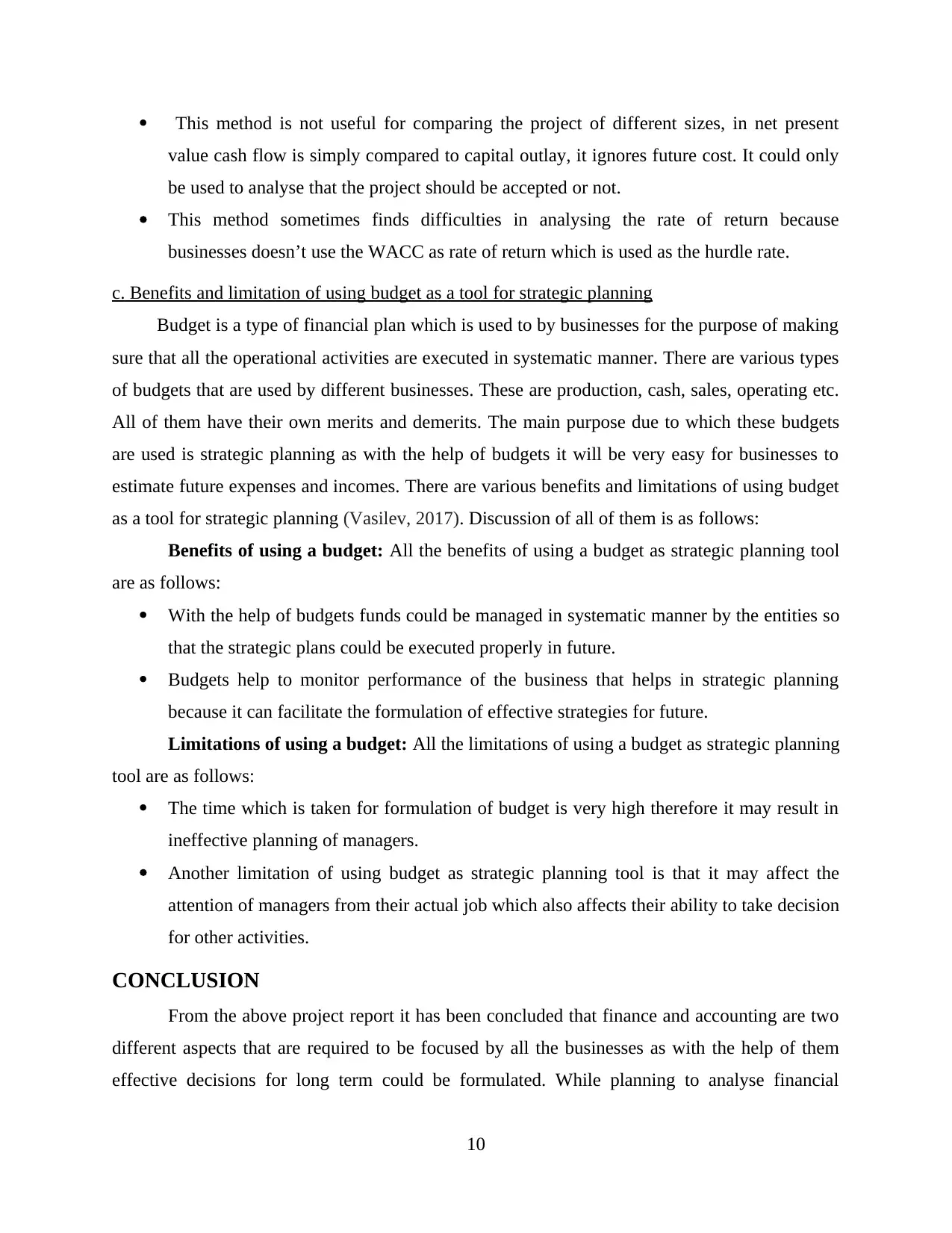
This method is not useful for comparing the project of different sizes, in net present
value cash flow is simply compared to capital outlay, it ignores future cost. It could only
be used to analyse that the project should be accepted or not.
This method sometimes finds difficulties in analysing the rate of return because
businesses doesn’t use the WACC as rate of return which is used as the hurdle rate.
c. Benefits and limitation of using budget as a tool for strategic planning
Budget is a type of financial plan which is used to by businesses for the purpose of making
sure that all the operational activities are executed in systematic manner. There are various types
of budgets that are used by different businesses. These are production, cash, sales, operating etc.
All of them have their own merits and demerits. The main purpose due to which these budgets
are used is strategic planning as with the help of budgets it will be very easy for businesses to
estimate future expenses and incomes. There are various benefits and limitations of using budget
as a tool for strategic planning (Vasilev, 2017). Discussion of all of them is as follows:
Benefits of using a budget: All the benefits of using a budget as strategic planning tool
are as follows:
With the help of budgets funds could be managed in systematic manner by the entities so
that the strategic plans could be executed properly in future.
Budgets help to monitor performance of the business that helps in strategic planning
because it can facilitate the formulation of effective strategies for future.
Limitations of using a budget: All the limitations of using a budget as strategic planning
tool are as follows:
The time which is taken for formulation of budget is very high therefore it may result in
ineffective planning of managers.
Another limitation of using budget as strategic planning tool is that it may affect the
attention of managers from their actual job which also affects their ability to take decision
for other activities.
CONCLUSION
From the above project report it has been concluded that finance and accounting are two
different aspects that are required to be focused by all the businesses as with the help of them
effective decisions for long term could be formulated. While planning to analyse financial
10
value cash flow is simply compared to capital outlay, it ignores future cost. It could only
be used to analyse that the project should be accepted or not.
This method sometimes finds difficulties in analysing the rate of return because
businesses doesn’t use the WACC as rate of return which is used as the hurdle rate.
c. Benefits and limitation of using budget as a tool for strategic planning
Budget is a type of financial plan which is used to by businesses for the purpose of making
sure that all the operational activities are executed in systematic manner. There are various types
of budgets that are used by different businesses. These are production, cash, sales, operating etc.
All of them have their own merits and demerits. The main purpose due to which these budgets
are used is strategic planning as with the help of budgets it will be very easy for businesses to
estimate future expenses and incomes. There are various benefits and limitations of using budget
as a tool for strategic planning (Vasilev, 2017). Discussion of all of them is as follows:
Benefits of using a budget: All the benefits of using a budget as strategic planning tool
are as follows:
With the help of budgets funds could be managed in systematic manner by the entities so
that the strategic plans could be executed properly in future.
Budgets help to monitor performance of the business that helps in strategic planning
because it can facilitate the formulation of effective strategies for future.
Limitations of using a budget: All the limitations of using a budget as strategic planning
tool are as follows:
The time which is taken for formulation of budget is very high therefore it may result in
ineffective planning of managers.
Another limitation of using budget as strategic planning tool is that it may affect the
attention of managers from their actual job which also affects their ability to take decision
for other activities.
CONCLUSION
From the above project report it has been concluded that finance and accounting are two
different aspects that are required to be focused by all the businesses as with the help of them
effective decisions for long term could be formulated. While planning to analyse financial
10
⊘ This is a preview!⊘
Do you want full access?
Subscribe today to unlock all pages.

Trusted by 1+ million students worldwide
1 out of 14
Related Documents
Your All-in-One AI-Powered Toolkit for Academic Success.
+13062052269
info@desklib.com
Available 24*7 on WhatsApp / Email
![[object Object]](/_next/static/media/star-bottom.7253800d.svg)
Unlock your academic potential
Copyright © 2020–2025 A2Z Services. All Rights Reserved. Developed and managed by ZUCOL.





